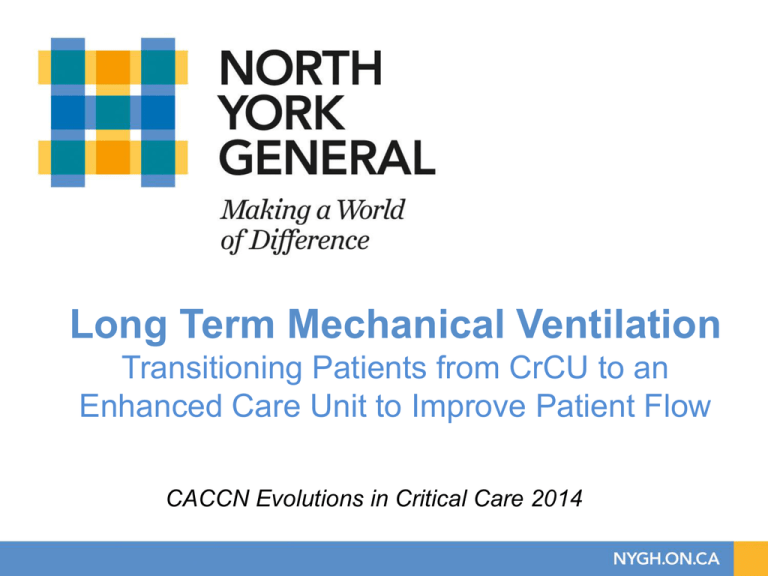Long Term Mechanical Ventilation Patients
advertisement

Long Term Mechanical Ventilation Transitioning Patients from CrCU to an Enhanced Care Unit to Improve Patient Flow CACCN Evolutions in Critical Care 2014 Darlene Baldaro, BSc, RRT, PPL/Clinical Respiratory Educator, Respiratory Therapy and Professional Practice Tina Chopra BScN, RN, Clinical Nurse Educator, Neuro-Stroke Medicine Unit Danielle Ferreira, RN, BScN, BHSc, Clinical and Special Projects Coordinator/Critical Care Response Team Co-Lead, Critical Care Department Background 2004/05: Ministry launched Critical Care Transformation Strategy Purpose: improve quality of care and system performance in adult critical care services1 Findings: • Critical care bed capacity increasingly limited across province1 • Contributing factor to shortage - use of ICU beds for medically stable chronically ventilated patients1 • No adequate alternative setting appropriate for these patients1 1. Chronic Ventilation Strategy Task Force Final Report, June 30, 2006 Long Term Mechanical Ventilation Patients Those patients suffering from a severe respiratory impairment who require ventilatory support for more than 6 hours per day for more than 21 days, but who do not require additional services provided by a CrCU.1 LTMV Chronic Ventilation Strategy Task Force Final Report, June 30, 2006; page 11. Patient 19 year old male with Duchenne muscular dystrophy PMHx: wheelchair bound, cardiomyopathy Suffered a left MCA stroke complicated by aspiration pneumonia Admitted to KGH then transferred to NYGH Intubation Trach Failed TM trials, PAV trials considered ventilator-dependent Liaised with WPH: Discussions – home or complex care centre Patient and family resistance due to fear of transition out of ICU Background Demand for ICU beds for this patient population projected to increase by 92 - 120% over the next 25 years1 Historically, these patients remain in ICU until an alternative care setting is secured in either the community or a chronic ventilator unit.1 The wait time for a LTMV bed can be several months to years.2 Recognition that we needed to change and invest in how we manage LTMV patients.1 1. 2. Chronic Ventilation Strategy Task Force Final Report, June 30, 2006 Long-term Ventilation Service Inventory Program. Final Report. July 31, 2008. Background The Ontario Chronic Ventilation Strategy Task Group was established to address Access to Services and Wait Time Strategy.1 Mandate: a. Identify strategies to facilitate the transfer of medically stable, LTMV patients out of ICUs and into a more appropriate care settings.1 b. Prepare a care strategy and related resource allocation recommendations to address their needs.1 1. Chronic Ventilation Strategy Task Force Final Report, June 30, 2006 Care Setting 2 2 CCC Inpatient medical ward 2. Long-term Ventilation Service Inventory Program. Final Report. July 31, 2008. Interprofessional LTMV Transition Planning Group To improve patient flow and increase critical care capacity, these patients, at times, are transferred to an inpatient medical unit. However, acute care hospitals were surveyed through PPNO and the majority response indicated this was not common. Our Innovative Solution: Transition care of LTMV patients from our CrCU to the wards Enhanced Care Unit (ECU) 3 bed intermediate care unit (not a step-down) Located on a regular inpatient medical unit (Neurology & Stroke) Utilized for patients ready for transfer out of the ICU but have ongoing complex care needs e.g. tracheostomy patients with frequent suctioning Staffed with ward nurses Intermittent monitoring 1 nurse: 2 patients 2 nurses: 3 patients (today) Transitioning Patients from CrCU to ECU Purpose: • To enhance patient quality of life • Improve patient flow with improved bed turns • Improve access to CrCU • Increase critical care capacity • Better utilization of resources • Interprofessional collaboration • Professional development • Maximize scope of practice Interprofessional LTMV Transition Planning Group Interprofession al LTMV Planning Group • Transfer of Care • Mentorship Collaborative IP • eDocumentation Mentorship & • Pt Concern Algorithm Support Contingency Plan • Teaching package • Interactive education sessions • Pre and post confidence survey IPE Needs Assessment Patient and Family Communication Plan • Chronic Ventilator • Motorized wheelchair • Mobility devices for ambulation • Social media devices •CrCU, RRT, Inpatient Unit interprofessional HCP •Coordinated coverage between GIM and CrCU MDs •Patient & Family •LTMV Patient Care Plan Project Timeline January 2013 • Monthly Transition Planning Meetings • Developed Patient Concern Algorithm • Chronic ventilator trial •IS documentation • Communication Plan to CrCU and RRT staff February 2013 • Communication re: physician coverage • Developed IP Patient Care Plan • Developed Education Plan March 2013 • Communication to ECU staff April 2013 • Communication to Patient/family • IPE provided • Allied Health Team Meeting Transition Go Live! • CrCU Nursing mentorship • RRT mentorship • Mobility training (PT, CrCU Team Attendant with Unit RN/PT/PTA Future Build capacity Training and Support Interactive workshop • • • • 22 participants Performance skills stations and simulation scenarios Performance evaluation competency assessment Post evaluation survey CrCU Interprofessional PFCC Team Patient Family Centred Care (PFCC) Mentorship Interprofessional: • CrCU Team → ECU Team (e.g. RRT→ RN) Intraprofessional: • CrCU nurses → ECU nurses • CrCU Allied Health → ECU Allied Health Inpatient Unit Nursing Response to Mentorship 87.5% responded to the survey; 100% of respondents were positive “It increased my self-confidence and understanding how to look after patient on ventilator.” “They were able to encourage and mentor really well.” “Increased confidence.” “It gives me confidence that somebody is available in case I needed help.” “ICU nurses very helpful.” “Parameters and when to ask for help with the CCRT and RT was helpful.” Enhanced Care Unit PFCC Team Results Patient Update Transferred to chronic ventilator Family participation in care Daily outings on hospital grounds; occasional external outings Visited complex continuing care chronic ventilator unit Improved quality of life with patient directing their care Increased Capacity/Bed Turn in the CrCU Chronic Vent Business Case Analysis • Increase capacity is based on average LOS for our CrCU patients of 5.1 days applied to the extra bed days made available by relieving chronic vent pressures • Based on the initiative to move chronic vents out of the CrCU there could be an increase in annual fiscal capacity/bed turns of: Extra Daily Capacity Increased Fiscal Average Monthly by relieving chronic Capacity/Bed Turns @ Increase vent bed pressure CrCu ALOS *(5.1 days) Capacity/Turns 3 2 Average Source: Critical Care Information System (CCIS) 215 143 179 18 12 15 Conclusion The IP project group identified barriers, implemented resources and effective strategies to facilitate the transfer of care of a LTMV patient from the CrCU to an inpatient medical unit. A vast amount of coordination and collaboration of education, mentorship and care was completed. The IP, collaborative PFCC effort between the CrCU, RRT and ECU Teams enabled a successful transition. Where We Are Today ECU policy and standard of care Continued family involvement and training Increased census of patients in the ECU Model of care is continually evolving; Increase skill mix to include RPNs Continue to liaise with Alternative Care Settings for disposition and best practices in LTMV management Need to monitor efficiencies and effectiveness, i.e. bed turns, surge in CrCU Need to monitor calculated days for ECU blocked beds Questions Special Thanks To: Interprofessional LTMV Planning Group Susan Woollard, RN, Project Manager Dr. Donna McRitchie, MD Dr. Phil Shin, MD Millie Paupst, MD Wendy Cheung, RN Marina Bitton, RN Elizabeth Villar-Guerrero, RN Sandra Ramdeyall, RN Tanya Chinner, RRT Jo-Ann Fernando, RN Kathy Tossis, PT Tova Milnes, Taheera Habib, SW Debbie Conway-Chung, RN References 1. 2. 3. 4. 5. The Chronic Vent Strategy Task Group. Chronic ventilation strategy task force: final report [Internet]. Toronto: The Ministry of Health and Long-Term Care; 2006 Jun 30. [cited 2013 Jan]. Available from: http://www.health.gov.on.ca/english/providers/program/critical_care/docs/report_cvtg.pdf National Long Term Mechanical Ventilation Steering Committee. Long-term ventilation service inventory program: final summary report [Internet]. The Ministry of Health and Long-Term Care: Toronto; 2008 Jul 31. [cited 2013 Jan]. Available from: http://www.rtso.ca/themes/acquia_marina/pdfs/LTV%20SIP%20Summary%20Report-FINAL.pdf College of Respiratory Therapists of Ontario. Optimizing respiratory therapy services: a continuum of care from hospital to home [Internet]. Toronto: The College; 2010 Jun. [cited 2013 Jan]. Available from: http://www.crto.on.ca/pdf/ProfPractice/HFO_Final_Report.pdf Improving the experience of patients requiring or at risk of long-term mechanical ventilation final report. July 2010. McKim DA, Road J, Avendano M, Abdool S, Côté F, Duguid N, et al. Home mechanical ventilation: A Canadian Thoracic Society clinical practice guideline. Can Respir J [Internet]. 2011 [cited 2013 Jan];18(4):197-215. Available from: http://www.respiratoryguidelines.ca/sites/all/files/2011_CTS_HMV_Executive_Summary.pdf











